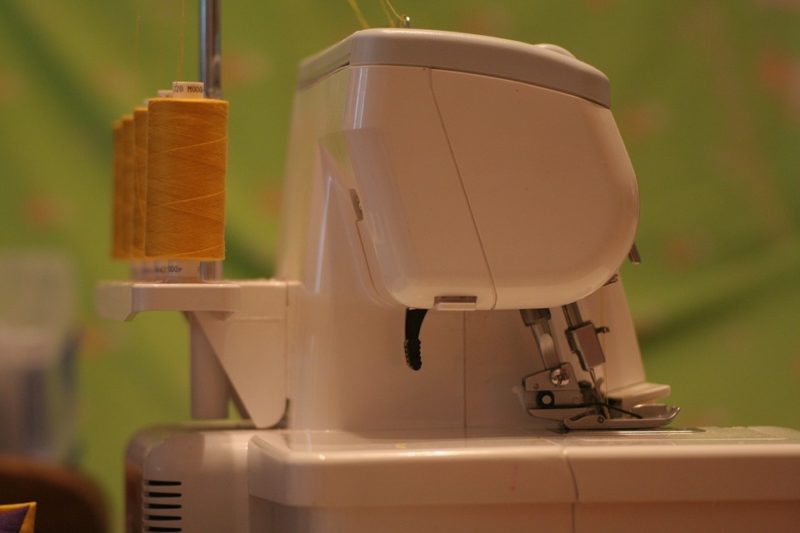The answer to what is serging in sewing is that it’s a technique to finish the project’s edges. One can even consider it as seaming. We will talk about its uses below and even differentiate serging from sewing.
Speaking of serging, do you know what is a serger sewing machine? You can think of it as a specific type of machine for this sewing method. Give that a quick read as well in case you don’t want to serge manually.

What Does Serging Mean In Sewing?
Serging is the process of stitching the fabric edges when sewing. It is also how you’ll typically finish the seams of most sewing projects to keep the fabric edges from unraveling. Please do not confuse it as another technique from overlocking since the two terms are interchangeable.
It would benefit you to know how to serge or overlock your projects not just because it helps with the longevity of the fabric edges. The finished project will look more professional if you serge them as well. The good news with this technique is that you can do it by hand, zigzag stitches with a sewing machine, or with an overlocker, a special machine that will seam, trim, and finish the material for you.
What Is The Purpose Of Serging?
To finish the seams and edges
The most common purpose of serging is to finish the seams and edges of sewing projects. This way, the material won’t unravel, and you won’t need to worry about securing fabrics, especially those that stretch. You can also use the overcast stitch found in some sergers to finish the edge of a single fabric layer for a more durable project.
For decorating seams and perfect hems
Serging the seams and edges of your fabrics is not only helpful in keeping them durable and professional-looking. You can also use serging as a way to create decorative seams or flatlock seams. Furthermore, it’s easy to make uniform rolled hems ideal for projects like napkins and scarves if you know how to serge.
For gathering fabrics
Serging can help sewers gather fabrics and make the process more comfortable. There is even a feature in some sergers that is dedicated to gathering fabric. Nonetheless, knowing how to serge might also make your sewing experience more efficient since you can use it to gather materials temporarily.
What Is The Difference Between Sewing And Serging?
Both sewing and serging are ways to make stitches. Serging is also a sewing technique, but its primary purpose is to finish the fabric edges to keep them from unraveling and get a more professional-looking finish. Furthermore, there are different sewing techniques, while serging is essentially an overlock stitch.
Sewing machine vs serger
A serger can be considered as a particular type of sewing machine that uses an overlock stitch. It is worth getting this separate unit if you work on multiple projects that demand to be done quickly. On the other hand, it’s possible not to get one and use your sewing machine to finish seams using a lockstitch or a chain stitch instead.
Some notable differences that will make it easy to identify a serger from a regular sewing machine include:
- Sergers are only capable of an overlock stitch compared to a sewing machine that offers multiple types of stitches
- Sergers can use up to three threads, and they are also capable of cutting the material
- Sewing machines work slower than sergers
- Sergers are only capable of sewing to the left of the needles
And if you’re curious about the similarities between a sewing machine and a serger:
- Both can do a rolled hem
- Both can do piping
- Both can gather fabric
You can benefit from knowing how sewing machines work as well to further understand the differences between these two devices.
What Stitch Can I Use Instead Of Serging?
Do not worry if you don’t know how to serge with overlock stitches or have a serger. You can still finish the seam of your projects using other stitches such as zigzag or straight stitches.
Zigzag stitch
You can use a zigzag stitch to finish the seam of your project instead of serging. This type of stitch will also work well if you’re using medium to heavy materials. And compared to other seam finishes, the zigzag stitch is a fast way to make durable edges, so it’s perfect for people doing many projects for a certain period.
Straight stitch
Another way to finish the edges of the fabric without serging is with straight stitches. This method is perfect for people with basic sewing machines only capable of straight stitching. To finish the seam, turn the raw edges under by 1/4 inch and straight stitch.
Conclusion
And that’s it! To recap what is serging in sewing, it is essentially an overlock stitch for finishing the seams and keeping the fabric edges from unraveling. There is even a specific machine called the serger for this sewing technique.
However, you can also use your sewing machine to finish the edges of the project. We hope this was a helpful read; leave us a question if you have any.
